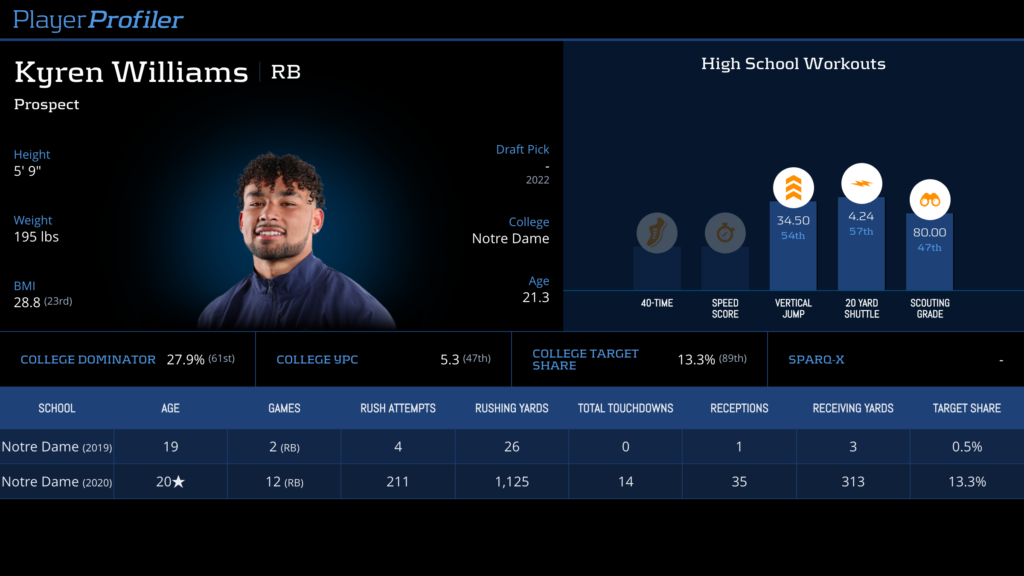
This article is the third in a series in which I evaluate 2022 rookie running backs solely on their ability to run the ball. The first installments focused on former Texas A&M runner Isaiah Spiller and Michigan State product Kenneth Walker III and can be found here. If you happened to already catch those and don’t need a refresher on my methodology, feel free to skip to the player-focused analysis below the picture of Notre Dame’s Kyren Williams a couple paragraphs down.
Outside the ability of whoever happens to be running the ball, there is a whole mess of variables that factor into the effectiveness of a given rushing attack; scheme, play-calling tendencies, opponent strength and scheme, weather, offensive line play, surrounding skill-position talent, etc. And given this entanglement, separating the contributions of the ball carrier from the offensive environment in which he operates is not a straightforward task. My approach to doing that is centered around measuring the degree to which a running back is over- or under-performing the per-carry output of the other running backs on his team.
Starting from the premise that good runners do more with what they are given than do bad runners, it stands to reason that, provided players are operating under generally the same conditions (like, for example, playing on the same team), better backs should produce more per carry than lesser backs. Using this logic, we can establish a baseline for comparing efficiency between players on the same team; for each running back, we can compare his performance (X) to the collective performance of every other running back on the team (Y). If X > Y (essentially, if dude is doing more with his carries than his teammates are with theirs), we can probably conclude that the player in question is a good player, at least to some relative degree.
Assuming that this is a sound method of evaluating running backs relative to their teammates, we can then extend our comparisons to players from other teams (we’re really just creating a baseline for efficiency comparisons similar to how Dominator Rating and other market share-based metrics create baselines for volume-based comparisons).
The key metrics I use to evaluate running back performance vs. that of their teammates are called Yards Per Carry+ and Chunk Rate+. I also like to use a metric called Breakaway Conversion Rate, but that is not a teammate-relative measure and we’ll therefore look into it separately.
The metrics are pretty straightforward: YPC+ is the degree to which a player over- or under-performs his teammates in yards per carry, and Chunk Rate+ is the degree to which a player over- or under-performs his teammates in rate of “chunk” runs (which I classify as runs of 10 yards or more). At a basic level, I want my running back prospects to find a way to produce more per carry than the other backs on the team, and part of that puzzle is navigating the line of scrimmage and extending runs into the secondary at a higher rate than his backfield mates. YPC+ and Chunk Rate+ measure the degree to which a player does both of these things.
THE METRICS

The good news for Kyren Williams stans is that the halfback of Notre Dame (you know, Quasimodo predicted all of this) outdid fellow Fighting Irish runners in the yards per carry department during his three seasons at South Bend. As a general rule, I want my running back prospects to be more productive and more efficient than their non-NFL quality teammates. Williams was that on a per-carry basis, albeit against a group of runners that came into college as 3.04-star recruits on average, a 44th-percentile group. The bad news is that he barely was so. He leaves college with a YPC+ mark of 0.03, a 30th-percentile figure among backs drafted since 2007.
With only four carries in his true freshman season, his career at Notre Dame is really the tale of two seasons from a rushing efficiency perspective. In 2020, he lagged behind his teammates in per carry output by 0.50 yards on his 211 rushing attempts. And in 2021, he averaged 0.54 yards more per carry than other Irish runners on a similar carry load with 204 attempts. The difference in those results can partially be explained by looking at his performance in Chunk Rate relative to his teammates.
In 2020, he put a -4.62-percent Chunk Rate+ on wax that would land in just the 8th-percentile. He improved to a point in 2021 where he was ripping off 10-yard runs at essentially the same rate as others on the team. Good for a CR+ of -0.65-percent which, while still just a 34th-percentile mark, is at least in the range of mediocre rather than abysmal.
Williams was also better as a big-play producer in 2021 than in 2020. As a sophomore, he converted 10-yard runs into 20-yard runs at a 34th-percentile rate of 27.59-percent. He did so at a 32.00-percent rate as a junior, a 57th-percentile performance. Breakaway Conversion Rate is inherently a relatively small-sample metric. But it is encouraging that Williams’ growth here matches his growth in Chunk Rate+ (and, as an extension of the two, YPC+), indicating that he might simply be improving as a ball-carrier over time.
TO THE INFALLIBLE RB MODEL
As of now, the numbers paint a picture of a runner who just doesn’t quite have it all together. And Williams’ resulting showing in my running back model’s Rushing Efficiency Score (a composite that accounts for all the metrics touched on in this article, in addition to overall team quality, offensive line play, opponent strength, and rushing volume) is just a 31.2 out of 100.
My running back model also generates comps based on the above factors combined with physical profile. If we make some assumptions about what Williams will look like at the Combine (let’s say he runs a 4.45 and is the 5-9, 195-poundsthat Notre Dame has him listed at), the 10 most similar prospects to him as pure runners are the following:

Clearly, this list is not made up of ball-carrying world-beaters. Raheem Mostert is probably the guy who we can say was the most successful in the league as a “pure runner” (and landing with the Kyle Shanahan-led 49ers probably had a lot to do with that). Because it probably won’t happen for him based on his ability to run the ball, like the other guys on this list who provided fantasy utility at points in their careers (Dion Lewis, Andre Ellington, and Miles Sanders), Williams will likely need to bring value as a pass-catcher in order to carve out a role in the NFL.
LAST WORD
As one of the best receiving running backs in this class and as a guy who produced well at a powerhouse program, Kyren Williams certainly has a chance to carve out a niche at the pro level. His path to success is simply more likely to be in the classic Nyheim Hines or James White satellite back mold than it is to be in the Matt Breida-level pure runner or the Austin Ekeler-type dual threat archetypes.
